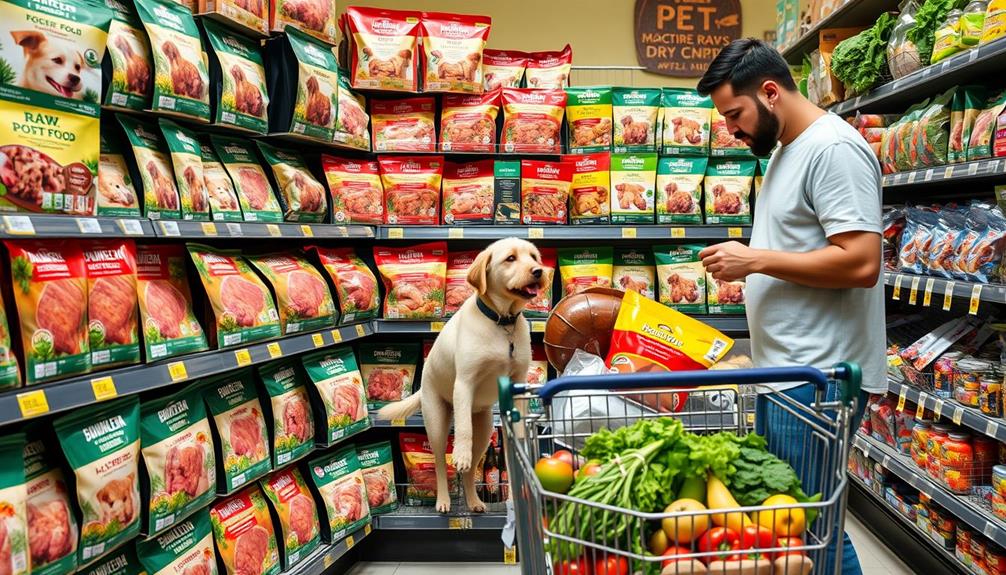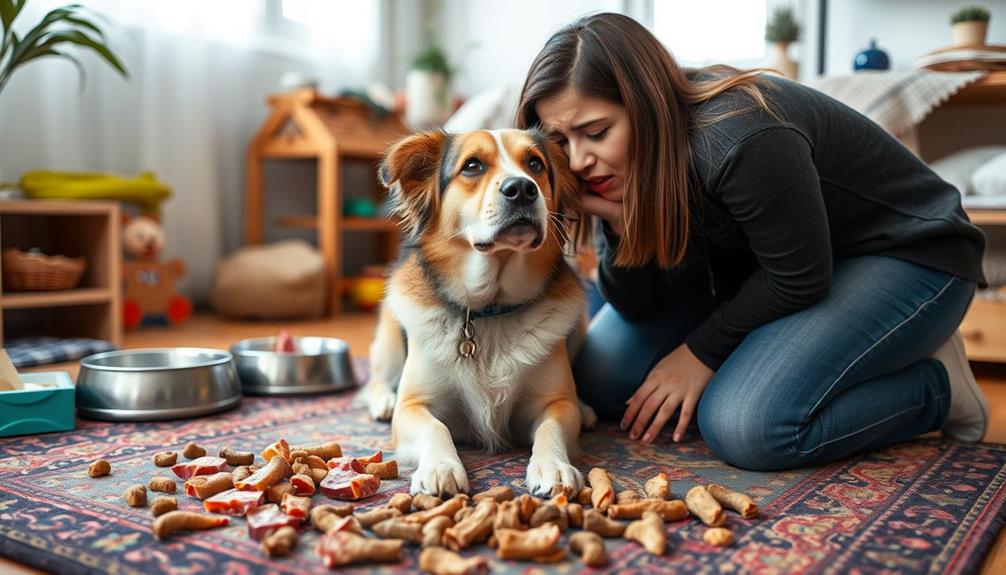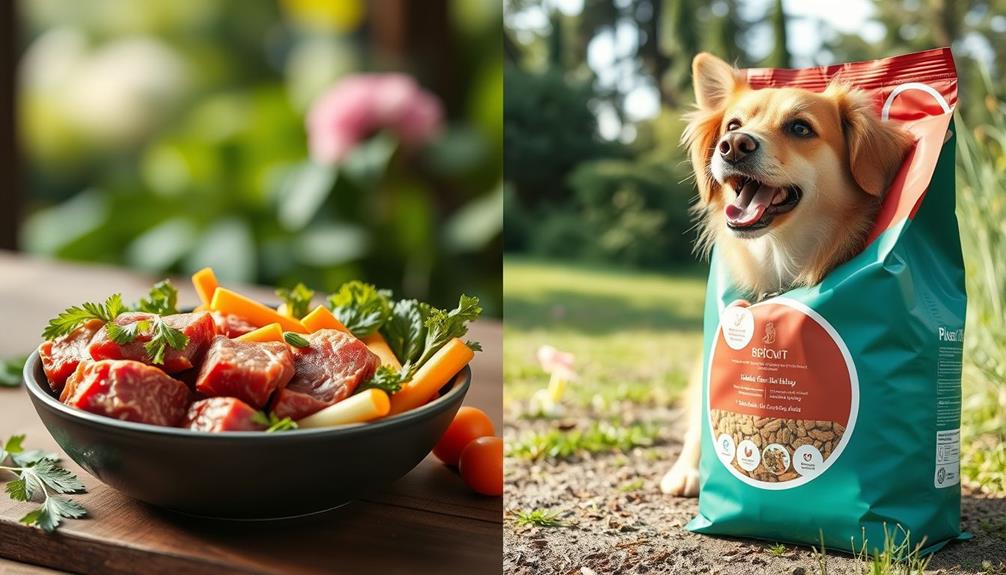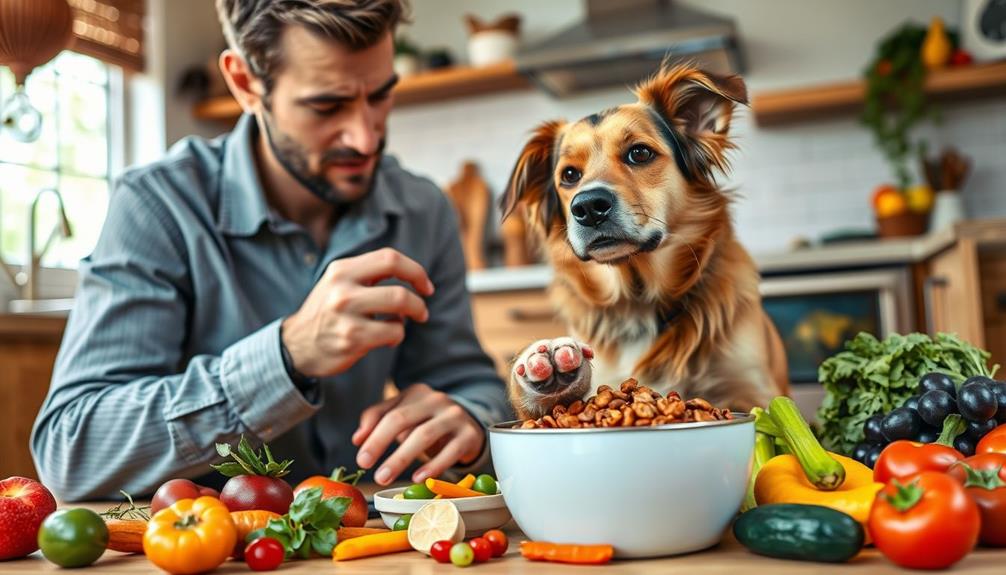Feeding your dog a raw food diet typically costs between $100 and $300 per month, depending on their size and dietary needs. For a 50-pound dog, the daily cost averages around $2.38, which is comparable to the price of one cup of coffee. While raw food may seem pricier upfront, it can lead to substantial savings in veterinary bills due to better health and fewer illnesses. You might also explore subscription services for added convenience and bulk buying options. If you keep exploring, you'll uncover more tips on how to manage costs effectively.
Key Takeaways
- Average monthly expenses for raw dog food range from £100 to £300, depending on dog size and dietary needs.
- Daily costs for a 50-pound dog on a raw diet are approximately £2.38, slightly higher than kibble's £1.66.
- Subscribing to raw food services can lower monthly expenses for medium-sized dogs to around £50.53.
- Bulk purchasing raw food can significantly reduce costs per unit, benefiting multi-pet households.
- Investing in a raw diet may lead to lower lifetime veterinary costs, estimated at over £7,000 less than kibble.
Overview of Raw Food Costs
When considering the costs of feeding your dog a raw diet, you'll find that expenses can vary considerably based on your dog's size and specific dietary needs. Understanding your pet's nutritional requirements is essential, as proper budgeting for pet food can help you make informed choices.
The average monthly expense for raw dog food ranges from $100 to $300. If you're shifting from a high-quality kibble diet, you might notice an increase in daily feeding costs. For instance, a 50-pound dog might cost about £2.38 daily for raw food, which is similar to the price of one cup of coffee. If you choose to invest in pre-made, commercially available raw dog food, the cost may increase further. However, many pet owners argue that the health benefits of a raw food diet outweigh the additional expense. Therefore, a cost analysis of raw food diet for dogs should take into consideration potential health savings in the long run. Additionally, some dog owners prefer to prepare their own raw food, which may lower the monthly expense.
Using a subscription model can help manage feeding costs, starting at around £2.87 for a 500g tub. For a medium-sized dog consuming 300g daily, this translates to a daily cost of about £1.94. Buying larger bulk orders typically reduces the price per kilo, making it a more cost-effective option over time.
If you look at the lifetime costs, feeding a 50-pound dog on a raw diet is estimated at around $24,336, which is over $7,000 less than the lifetime cost of a kibble diet, potentially exceeding $31,522. This financial advantage might make the shift to raw worth considering.
Factors Affecting Raw Food Pricing
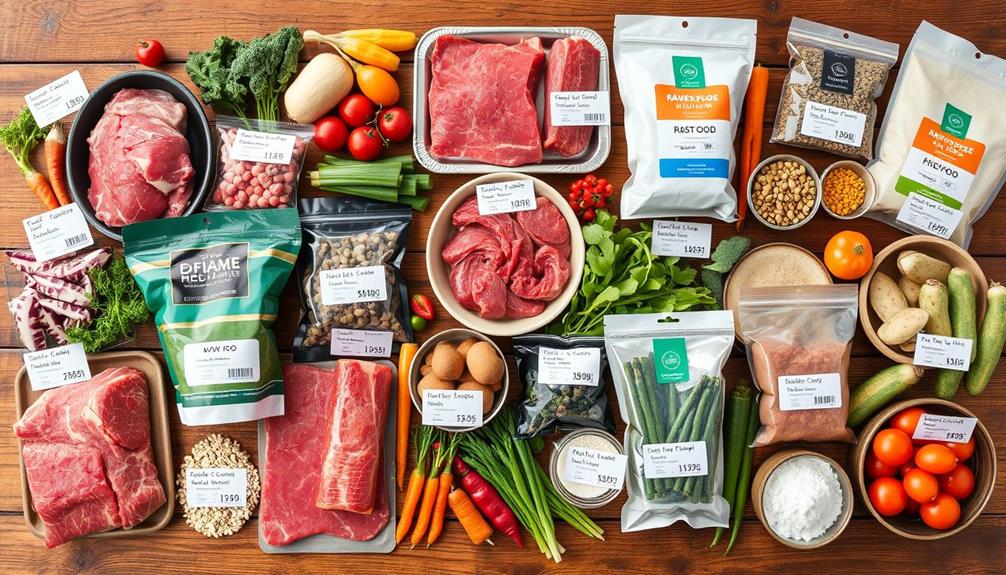
Several factors influence the pricing of raw food for dogs, making it important to understand what drives these costs. The cost of raw food can be considerably higher than kibble options, averaging between $5.00 to $6.00 per pound.
Juice diets may lead to nutrient deficiencies if not balanced, similar to how raw diets require careful ingredient selection.
Here are four key factors that affect raw food pricing:
- Quality Ingredients: Premium ingredients often come at a higher price. Foods sourced from reputable suppliers usually reflect their quality in the cost.
- Sourcing Practices: Where and how the ingredients are sourced can impact pricing. Sustainable and ethical sourcing typically results in higher costs.
- Food Type: The pricing may vary depending on whether the food is frozen, freeze-dried, or air-dried. Each method has different production costs.
- Bulk Purchasing: Buying in bulk or opting for variety boxes can lower the cost per unit, making raw food more affordable, especially for households with multiple pets.
Understanding these factors will help you make informed decisions about your dog's nutrition and budget for their raw food needs effectively.
Monthly Expenses for Dogs
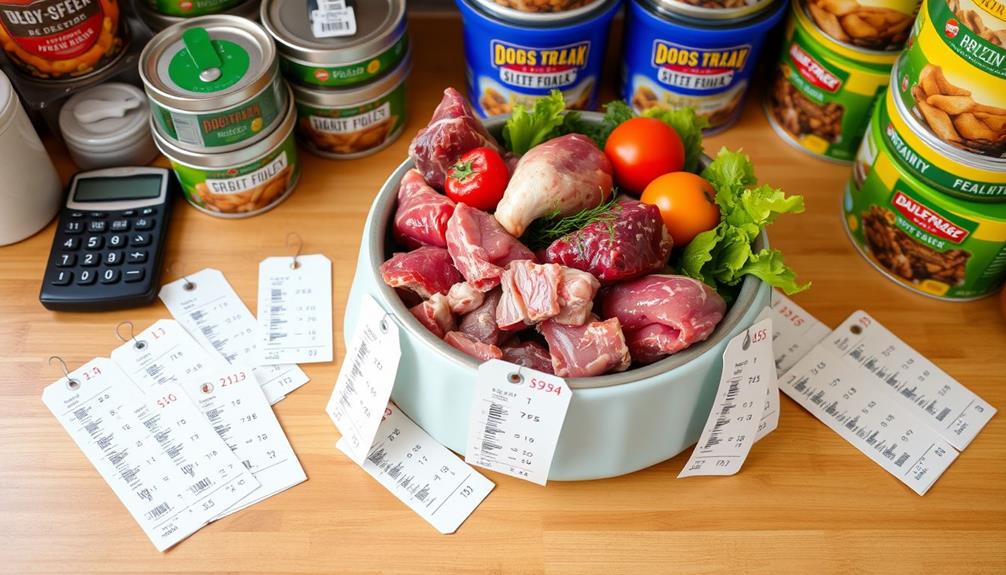
Feeding your dog a raw food diet can considerably impact your monthly expenses. For a medium-sized dog, you might find yourself spending anywhere from £100 to £300 each month, depending on your dog's size and specific dietary needs.
If you opt for a subscription service, you could start at around £50.53 monthly, based on a 500g tub priced at £2.87, with a recommended daily intake of about 300g. Additionally, incorporating essential oils for overall wellness may enhance your dog's health and support their shift to a raw diet.
As a pet parent, you might also discover that larger orders can reduce the price per kilo, making the overall feeding costs more manageable as you move to a raw diet.
While raw food can be around 1.5 times more expensive than high-quality grain-free kibble, the difference in daily costs—£2.38 for raw versus £1.66 for kibble for a 50-pound dog—might not be as significant as you think.
Furthermore, changing to a raw diet could lead to lower overall feeding costs due to better nutrient absorption, allowing you to feed less while meeting your dog's nutritional needs.
Cost Comparisons: Raw Vs. Kibble
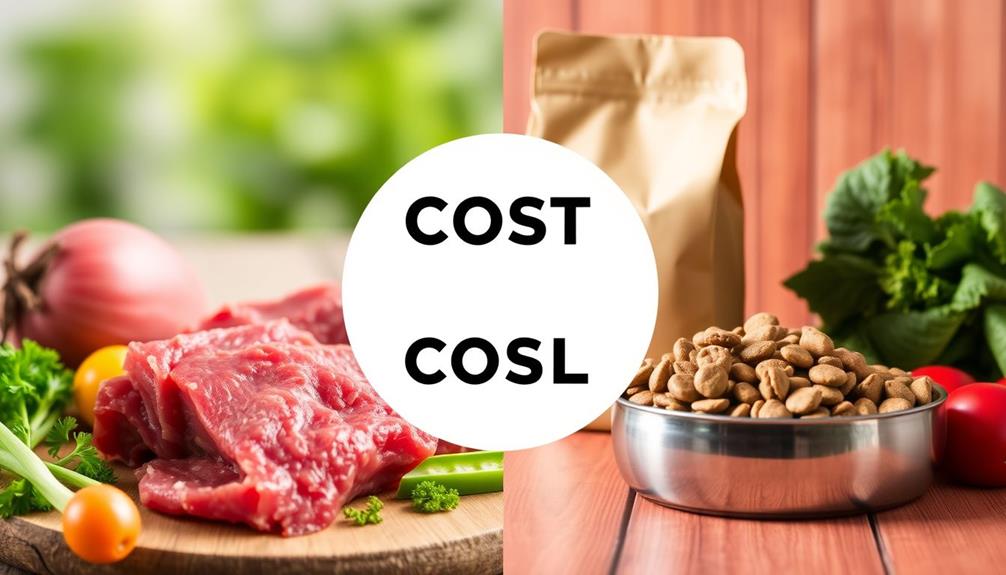
Shifting your dog's diet from kibble to raw food involves a noticeable difference in costs. While the initial investment in raw food can seem steep, understanding the cost comparisons can help clarify the long-term benefits.
A well-balanced diet, similar to ultimate hamster care, is essential for overall health. Here's a breakdown of the costs you might encounter:
- High-Quality Kibble: A 50-pound dog's daily kibble cost is around $1.66.
- Raw Food Cost: Changing to raw food, like Steve's Real Food, raises the daily cost to approximately $2.38.
- Mixed Diet: Feeding 75% kibble and 25% canned food costs about $2.37 daily.
- Complete Raw Diet: Shifting to a complete raw diet could save you over $1.00 daily compared to an 85% kibble and 15% freeze-dried food mix.
Though feeding raw comes with higher upfront costs, it may reduce health issues and lead to long-term savings on veterinary bills.
Investing in raw food can improve your dog's overall health, potentially decreasing the risk of chronic diseases. Ultimately, the change to raw food may not only be a dietary upgrade but a financially wise choice as well.
Subscription Services and Pricing
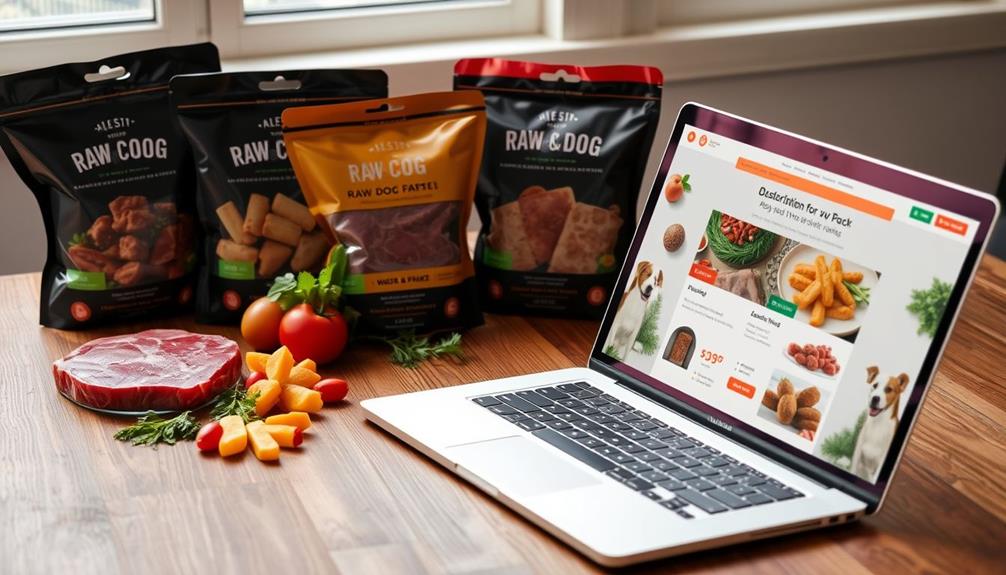
When you're exploring raw food options for your dog, subscription services can offer convenience and savings.
Many pet owners are turning to these services for their best websites to earn money online options, as they often provide cost-effective solutions.
Prices can vary greatly based on the brand and the size of the subscription, but bulk purchasing often leads to better deals.
Understanding these pricing variations can help you make the best choice for your furry friend.
Subscription Model Overview
Over the past few years, subscription models for raw dog food have gained popularity among pet owners looking for convenience and cost savings.
These subscriptions typically start at around £2.87 for a 500g tub, making them an accessible option for many. For a medium-sized dog, you can expect a daily cost of approximately £1.94, leading to a total estimated monthly cost of around £50.53 for 26 days of feeding.
Additionally, just as modern toilets with dual-flush systems help conserve resources, these subscriptions can aid in managing your pet's diet efficiently.
Here are some key benefits of subscription models for raw dog food:
- Cost Efficiency: Larger orders often reduce the price per kilo, helping you save more.
- Convenience: Regular deliveries mean you'll never run out of food for your furry friend.
- Variety: Many services offer different protein sources and meal formats, ensuring your dog has a diverse diet.
- Customization: You can tailor subscriptions to meet your dog's specific dietary needs and preferences.
Pricing Variations Explained
Pricing variations for subscription services in raw dog food can greatly impact your overall expenses. Generally, these services start at around £2.87 for a 500g tub, which can be a cost-effective option for many pet owners. If you have a medium-sized dog, their daily intake of raw food is about 300g, leading to an average monthly cost of roughly £50.53 when using subscription services.
Additionally, just as diversifying a retirement portfolio with options like a Gold IRA can provide financial protection, choosing a variety of raw food brands can guarantee your dog receives balanced nutrition.
However, keep in mind that prices can fluctuate considerably based on the brand you choose. Premium raw food options may range from £5 to £10 per pound, while more affordable brands often start at that £2.87 price point.
To help you gauge your expenses, many raw food brands offer cost calculators on their websites. These tools allow you to estimate your specific monthly costs based on your dog's size, dietary needs, and activity levels.
Ultimately, understanding these pricing variations can help you make informed decisions and find a subscription service that fits your budget while providing the best nutrition for your furry friend.
Bulk Purchase Savings
Regularly considering bulk purchases for raw dog food can lead to significant savings for pet owners.
By opting for subscription services, you can enjoy cost-effective options that cater to your dog's dietary needs while minimizing your average monthly expense.
Here are some key benefits of bulk purchasing:
- Lower Price Per Unit: Larger bulk purchases often reduce the price per unit, making it easier to maintain a raw diet.
- Discounts on Larger Orders: Many subscription services provide discounts for bulk orders, helping you save even more.
- Variety Boxes: Buying variety boxes, like 24 x 1 lb packs, allows you to stock up on different proteins without paying extra for single meal packs.
- Cost Calculators: Some brands offer cost calculators to help you determine your specific expenses based on your dog's size and feeding needs, ensuring you make budget-conscious decisions.
Budgeting for Raw Diets
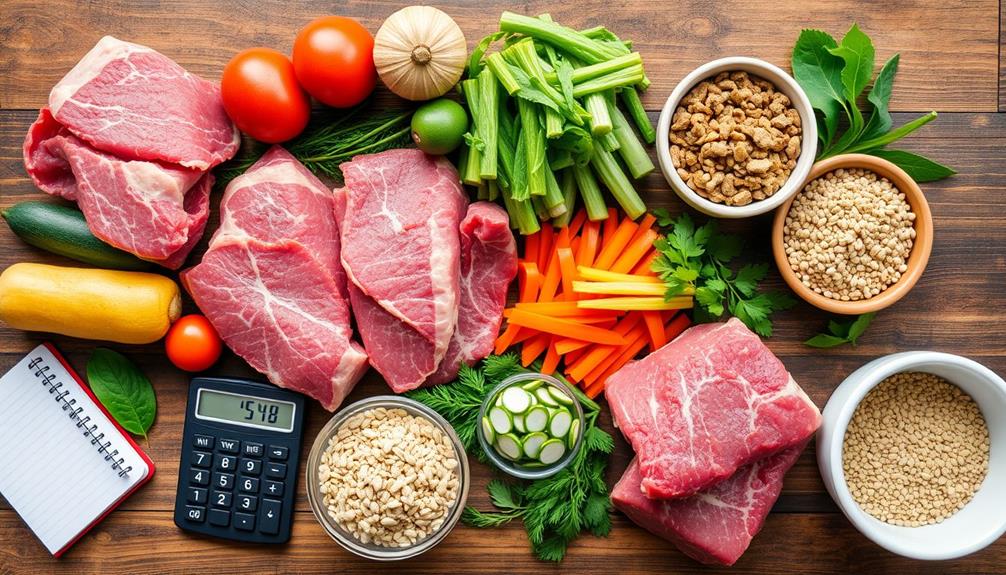
When budgeting for a raw diet for your dog, it's essential to evaluate several factors that influence overall costs. The average monthly expense can range from $100 to $300, depending on your dog's size, activity level, and specific dietary needs.
| Factor | Cost Range | Considerations |
|---|---|---|
| Pet Size | $50 – $150 | Medium dogs may cost around $50. |
| Protein Source | $20 – $200 | Chicken is cheaper than venison. |
| Bulk Purchasing | $80 – $250 | Reduces price per kilogram. |
Using cost calculators can help you pinpoint the exact expenses associated with your dog's raw food diet, making budgeting easier. For a medium-sized dog, a subscription for frozen raw food might start at about £2.87 for a 500g tub, leading to a monthly cost of around £50.53. By selecting cost-effective protein sources and considering your pet's size, you can manage your budget effectively and guarantee your dog receives the nutrition they need without overspending.
Cost-Effective Raw Food Options
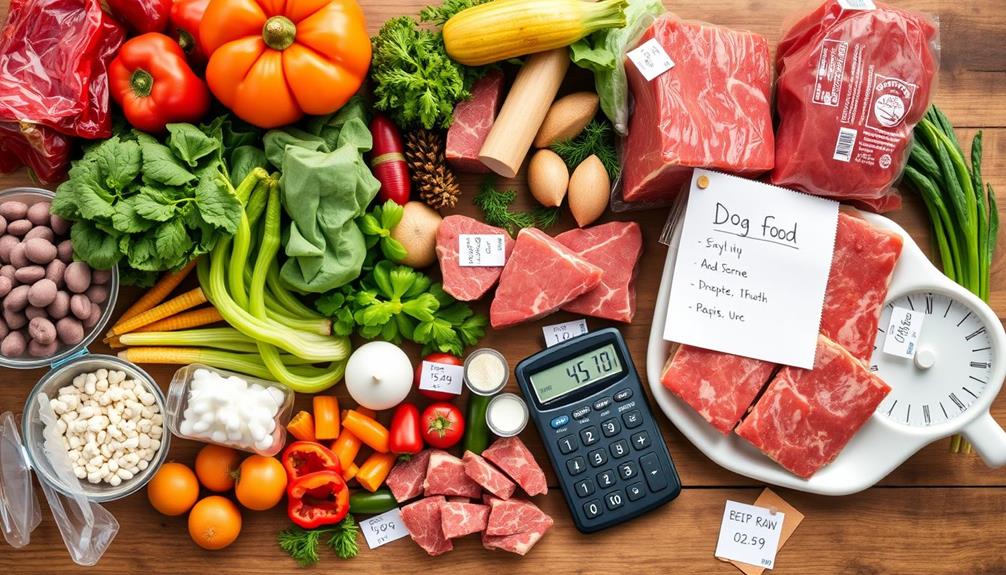
When you're looking to keep your dog's raw diet budget-friendly, affordable protein choices like chicken and turkey can make a big difference.
Additionally, incorporating healthy dog snacks made from natural ingredients can provide variety and nutrition for your pet.
Buying in bulk not only cuts costs but also simplifies your meal prep.
Plus, incorporating seasonal produce and bones can enhance nutrition while saving you money.
Affordable Protein Choices
Finding affordable protein choices for your dog's raw diet doesn't have to be overwhelming, as there are plenty of cost-effective options available.
In fact, incorporating a variety of protein sources can help guarantee balanced nutrition while keeping your feeding expenses manageable.
For example, benefits of rooibos tea highlight the importance of antioxidants, which can be beneficial for pets as well.
Here are some affordable protein sources to take into account:
- Chicken – Often one of the most economical options, great for regular feeding.
- Turkey – A lean alternative that provides essential nutrients without breaking the bank.
- Tripe – Nutrient-rich and typically less expensive, it's a fantastic addition to the diet.
- Beef – Look for sales or bulk purchasing options to reduce costs on this popular protein.
Bulk Buying Benefits
Maximizing your savings on raw food for your dog can be as simple as bulk buying. When you opt for bulk purchasing raw food, you can greatly reduce costs. Larger orders often lower the price per kilo, making it a more economical choice for pet owners.
Plus, variety boxes, like 24 x 1 lb packs, not only provide savings but also guarantee meal diversity for your furry friend, enhancing their dietary satisfaction. Incorporating unique breakfast and dessert recipes into your dog's diet can also keep their meals exciting and nutritious.
Many retailers frequently offer discounts on bulk purchases, allowing you to stock up on your dog's preferred proteins while saving on overall expenses. This is especially beneficial if you have multiple pets; dedicated freezers for storing bulk raw food can help you manage larger quantities efficiently, minimizing the need for frequent grocery trips.
Cost-Saving Meal Prep
Bulk buying is just one way to save on raw food for your dog, but cost-saving meal prep can further enhance your budget. By strategizing your meal prep, you can provide balanced nutrition without breaking the bank.
Here are some tips to keep costs down:
- Choose Cost-Effective Raw Proteins: Opt for chicken, turkey, tripe, beef, or lamb, which are often cheaper and nutritious options.
- Incorporate Seasonal Produce: Take advantage of fresh fruits and vegetables that are in season. They're typically less expensive and add variety to your dog's meals.
- Utilize Variety Boxes: Explore protein variety boxes, such as 24 x 1 lb packs. This helps prevent meal fatigue while ensuring you're not overspending.
- Add Bones to the Diet: Incorporating bones can lower your overall costs by 10-14% while providing essential minerals and promoting dental health.
Nutritional Value Vs. Cost
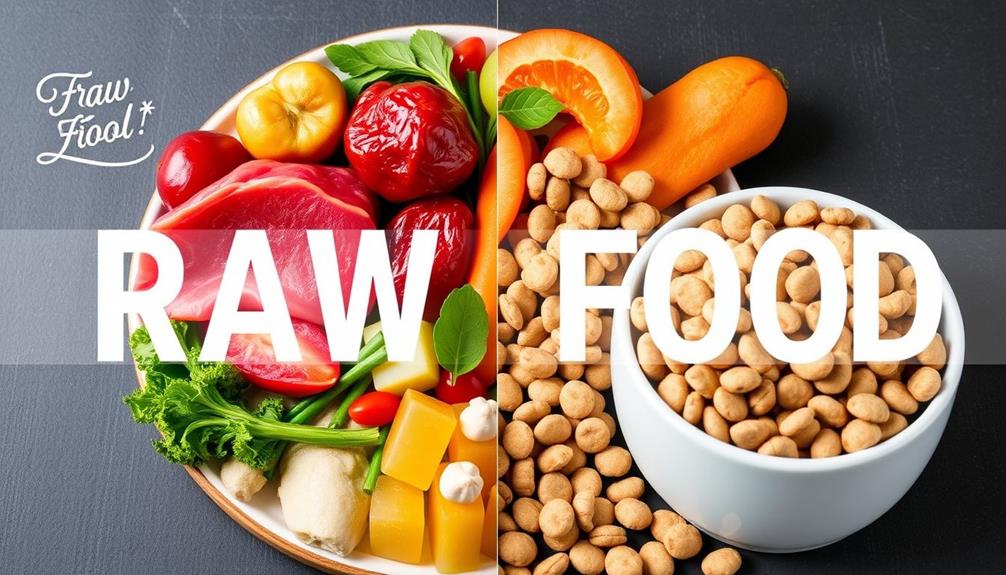
When considering the nutritional value versus cost of dog food, raw diets often present a compelling case for pet owners. While the average cost of a raw diet is around $5.51 per pound, considerably higher than specialty kibble at approximately $2.75, the nutritional benefits can justify this investment. A raw diet's higher bioavailability means your dog requires less food for adequate nutrition, potentially lowering daily expenses to about $1.94 for a medium-sized dog.
Investing in a raw diet can lead to improved coat condition, better dental health, and increased energy levels. These nutritional benefits may contribute to long-term health savings by reducing veterinary costs. Studies suggest that you could save over $7,000 in lifetime veterinary expenses compared to feeding kibble, which often contains low-quality ingredients linked to health issues.
You can further manage the cost of a raw diet by purchasing in bulk, which typically results in a lower price per unit. Although shifting to a raw diet may feel expensive initially, considering the long-term health implications and potential savings on veterinary bills makes it a worthwhile investment for your dog's well-being.
Long-Term Cost Considerations

Shifting to a raw diet involves upfront costs, but it's important to contemplate the long-term financial implications. While the initial investment might seem steep, feeding raw food can lead to significant savings over time.
Here are some key considerations for the long run:
- Lifetime Cost: Feeding a 50-pound dog a raw diet can cost around $24,336, which is over $7,000 less than kibble, potentially saving you money in the long run.
- Reduced Vet Visits: Proper nutrition from raw food may lower the likelihood of chronic diseases, meaning fewer vet visits and lower medical bills.
- Improved Pets Health: A balanced raw diet can enhance your pet's overall health, potentially preventing costly treatments for conditions like arthritis and chronic kidney disease.
- Long-Term Savings: Investing in quality nutrition can reduce the chances of serious health issues, which often come with hefty treatment costs—like $9,600 for kidney disease over six months.
Tips for Affordable Raw Feeding
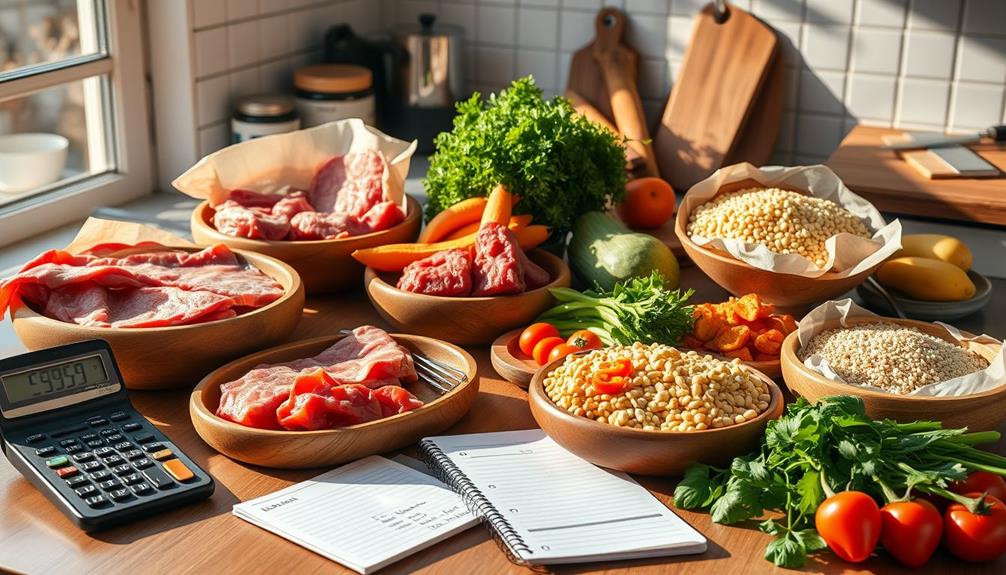
To make raw feeding more affordable, consider rotating cost-effective protein sources like chicken and turkey.
Buying in bulk can also save you money, especially if you've got multiple pets.
Plus, don't forget to explore budget-friendly ingredient options that keep your dog's diet balanced without breaking the bank.
Protein Rotation Strategies
Many pet owners find that rotating proteins in their dog's raw diet not only keeps meals exciting but also helps maintain a balanced nutrition profile without breaking the bank.
By incorporating protein rotation, you can effectively manage costs while ensuring your dog gets the nutritional value they need. Here are some strategies to make protein rotation cost-effective:
- Choose cost-effective proteins: Incorporate affordable options like chicken and tripe, which can greatly reduce your overall feeding expenses.
- Mix ground meat with organ meats and bones: This combination creates balanced meals at a fraction of the price of higher-end proteins.
- Utilize bulk packages: Purchasing bulk packages of meats can lower the cost per pound, allowing you to include a variety of proteins in your raw diet without overspending.
- Take advantage of seasonal produce and sales: Keep an eye on local sales for meats to enhance your dog's diet while maximizing your savings.
Bulk Buying Benefits
Bulk buying raw food can be a game-changer for pet owners looking to save money while providing nutritious meals. By opting for bulk purchasing raw food, you can considerably reduce the price per unit, which is especially beneficial for multi-pet households. Larger packages, like 2 lb meals or 24 x 1 lb variety boxes, often offer better value compared to smaller single meal packs.
Investing in a dedicated large or mini freezer for your pet meals can make a huge difference. It allows for better organization and storage of your bulk purchases, minimizing those frequent grocery trips.
Plus, properly managing freezer space enhances meal prep efficiency and helps keep your pet food fresh. This not only simplifies your routine but also leads to cost savings over time.
Buying in bulk isn't just about saving money; it also lets you stock up on your pets' preferred proteins, adding variety to their meals. This way, you can guarantee they enjoy their food while keeping your budget in check.
Embrace the benefits of bulk buying and watch your savings grow!
Budget-Friendly Ingredient Options
Finding budget-friendly ingredient options for your dog's raw diet can make a significant difference in maintaining a healthy and varied meal plan without breaking the bank.
Here are some tips to help you keep costs manageable while adapting your pet to raw:
- Choose Cost-Effective Proteins: Incorporate affordable raw foods like chicken, turkey, tripe, and beef. These options provide nutritional variety without the hefty price tag.
- Bulk Purchasing: Buy larger packages of raw ingredients. This strategy usually results in a lower price per unit, helping you save money on your dog's meals.
- Incorporate Seasonal Produce: Take advantage of seasonal fruits and vegetables. They're often cheaper during peak harvest times and can add essential nutrients to your dog's diet.
- Rotate Proteins: Regularly change up the protein sources you use. Not only does this prevent meal fatigue, but it also allows you to capitalize on sales throughout the year.
Frequently Asked Questions
How Expensive Is It to Feed Your Dog Raw Food?
Feeding your dog raw food can be a bit pricey. You'll likely spend around £50 a month for a medium-sized dog. However, the health benefits may justify the extra cost for many pet owners.
How Much Does Raw Dog Food Cost a Month?
Feeding your furry friend raw food can be like investing in a gourmet meal plan. You can expect monthly costs between $100 and $300, depending on your dog's size and specific dietary needs.
What Is the Cheapest Way to Feed My Dog Raw?
To feed your dog raw on a budget, focus on cost-effective proteins like chicken or turkey, buy in bulk, and incorporate seasonal produce. Don't forget to add bones for dental health and extra savings!
Is It Cheaper to Make Raw Dog Food?
Making raw dog food at home can save you money, averaging $2.00 to $3.00 per pound. By choosing cost-effective proteins and buying in bulk, you'll enjoy nutritious meals without breaking the bank.
Conclusion
In the end, choosing raw food for your dog can feel like a balancing act of costs and benefits. Imagine this: you're at the store, comparing prices, and suddenly you spot a great deal on a bulk pack of frozen meat. It clicks—feeding your pup healthy, raw meals doesn't have to break the bank. With a bit of planning and creativity, you can nourish your furry friend without sacrificing your budget. It's all about finding that sweet spot!

